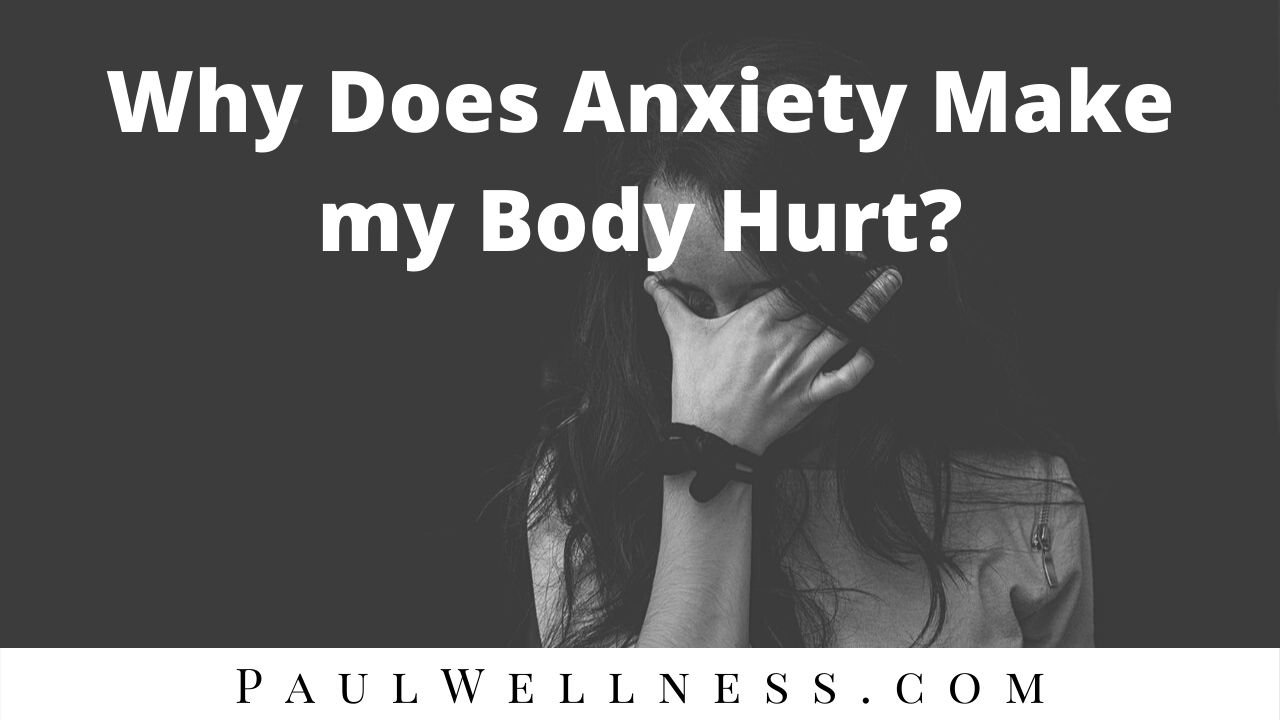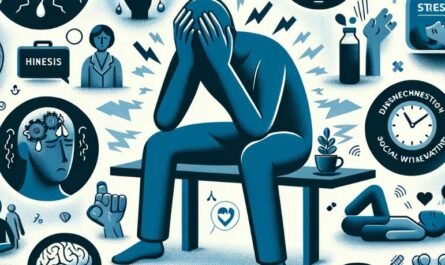Whether it’s feelings of anxiety or a true anxiety condition, it’s clear that this creates a whole range of physical symptoms. One of the most common symptoms is pain. There are common tension spots like the neck, back, jaw, arms, and more. Why does anxiety cause pain? What can you do about anxiety pains? I will answer both so you understand the symptoms better and feel more equipped to handle these issues.
No one likes being in pain. In truth, it’s been shown that anxiety causes pain and pain causes anxiety, so it traps you in a vicious cycle where one feeds the other. There are several reasons why pain is so common with anxiety and we will be exploring some of the biggest culprits here.
Hormones
What is anxiety at its core? It’s fear. It’s the feeling that something dangerous is right around the corner, ready to strike, and you have to prepare for it. Fight-or-flight kicks and your body automatically prepares to battle or run like crazy. This means breathing more rapidly. All that extra oxygen will help if you need to run away (though, strangely enough, this will make you feel like you’re not getting enough air. The human body is fun!).
Your muscles will strain, too. Blood will be pooled to your muscles as blood vessels around the heart and large muscle structures will dilate. You’ll need more blood to power your muscles when you’re fighting that would-be attacker. This also has the wonderful side effect of taking away blood from the brain (ever wonder why you can’t think as articulately when you’re angry or scared?) and your digestive system (this is why so many people with anxiety conditions also have digestive issues, but that’s for another time).
These automated responses are great if a bear is running after you or someone is trying to mug you. You want to be able to run faster and punch harder. But what about when the danger is only in your head, or far out of scope with the “real danger” in front of you? Anxiety can make someone who’s a little mean feel like a roaring lion ready to pounce.
All this muscle tensing, blood redistributing, and rapid breathing leads to muscle tension. You probably won’t feel it much if your fight-or-flight response only activates when there’s true danger, but you’ll feel the effects if you’re constantly feeling threatened. This muscle tensing becomes painful.
This is thanks to adrenaline and cortisol. While you can’t blame the hormones (they’re only doing their job), anxiety tricks us into thinking that we’re always about to be attacked and that danger is always just a few inches away.
Proper therapy, such as CBT, is able to reduce these feelings and to better calibrate your fear response so that you don’t feel this tension quite as often.
Tension Response
While automatic muscle tensing is certainly a culprit of anxiety pains, there is something to be said about your response to stress and tension. You may not even notice it, but you’re likely contributing to the pain by the way you’re sitting or how you respond to stress.
It’s common to slouch to the side or hang your neck when stressed. This leads to back, neck, and shoulder pains. Many people also grit their teeth (jaw pains) or ball their hands into fists (hand and forearm pains), and tensing the muscles in your legs can make them hurt all day.
If you’re unsure if this is happening to you, then simply watch how your body reacts when stressed. Do you tense any part of your body or let something go limp in defeat? Just make a mental note of it and try to correct that behavior. This isn’t easy, but it can reduce the pain sensation associated with anxiety.
Sleeping Too Long
You’re tired from all the pain, stress, and fear, so you want to sleep. There’s nothing wrong with a light nap, but what if you’re sleeping too long? Now “too long” is subjective, but we’ll be general here and say that you’re sleeping hours longer than you normally would. This can include naps and even just lying in bed for too long.
This is shown to cause pains, especially in terms of headaches. Research shows that sleeping too long causes too much serotonin to release, which can result in headaches and other pains. This can also disrupt your regular nighttime cycle and lead to other issues down the road (aside from pain and a poor night’s sleep).
Try to stay on a normal sleep cycle. Taking a short nap should be fine, but otherwise stay out of bed.
Not Exercising
The last thing you want to do when in pain is exercise. Your body already hurts, why would you want to put it through more pain? Great question! Exercise is able to release a cascade of endorphins that make you feel better and reduce feelings of pain once the workout is complete. Now, I don’t want to oversell exercise. It’s not going to cure anxiety, but it can help reduce the feelings while also reducing the pain associated with it.
However, the other problem here is that chronically avoiding exercise allows your muscles to weaken. This makes your body more prone to slouching and tensing when under stress, which results in more pain.
You don’t have to exercise all the time, but shoot for 3-4 times a week of moderate lifting or cardio exercise. Even a walk can be enough to reduce feelings of pain and stress.
Tips for Anxiety Pains
There are many relaxation techniques you can use to reduce the muscle tension and ease feelings of pain. While taking an OTC pain reliever is one such method, I am hesitant to recommend it since everyday use might be problematic. If you would prefer the medicine route (and there’s no shame in that), then please speak with your physician and get their recommendation for the right medication.
Breathing Exercises
Controlling your breathing is able to reduce feelings of anxiety and can help with anxiety pains. There are numerous breathing exercises and one isn’t necessarily better than the others. However, I’ll recommend the 4-7-8 method since it’s one of the easiest ones to learn. You can do this at any time and it should help calm your body in a matter of minutes.
Breathe in deeply to the count of 4. Hold your breath to the count of 7. Breathe out with a loud whoosh to the count of 8 (yes, the whoosh is important). Again, any breathing exercise is helpful for this, but controlling your breathing will reduce your heart rate, calm your body, and begin to ease the pain in your body. Plus, it will get your body out of fight-or-flight and back into parasympathetic mode, which is ideal for mental functioning.
Progressive Muscle Relaxation
This technique involves tensing a specific muscle group for several seconds before allowing the muscle to relax. It’s easy and should only take a few minutes to complete your whole body. I like to start with the feet and move up to the head. Just tense the specific muscles (like your calves or biceps), hold for several seconds, and then allow the muscle to return to normal. You don’t want to tense so hard that you hurt yourself, but enough so that the muscle feels hard.
Not only does this relax the muscle, but this makes you more aware of how your body feels and which muscles might feel more painful than others. By going group by group, you’ll bring attention to how the muscle group feels now and whether it’s already painful and tense. While this is focused on relieving physical tension, many people find it calms their minds as well.
Visualization
Seeing yourself in a relaxing place is wonderful for reducing feelings of stress and allowing your body to recuperate from the physical tension you’re undergoing. Give it a try and see how you feel.
Start by seeing yourself in a relaxing place. I’ll use a beach for this example, by anywhere relaxing to you is helpful. Visualize the beach in your mind. You’ll find this is most helpful when you consider all the details. How does the water sound? Is it a sunny day, or is there a comfortable cloud cover overhead? Are you walking along the beach or sitting in a comfy chair with an umbrella? Do you have a drink with you, or are you eating something?
The more details you include, the more real it feels. The more real it feels, the more relaxing it is. Try this and see how much your body relaxes.
Meditation
Meditation is simple to start and it helps to calm the mind and body. You don’t need to do it too long. Even a five or ten minute meditation is enough to calm your mind and reduce feelings of tension, stress, and pain. While this is something you can do by sitting or lying down anywhere, I find it best to listen to either music or a guided meditation. I personally find this calms my mind better and gives me better results, but some people prefer silence.
Just allow your body to get comfortable, close your eyes, and give yourself the time you need to meditate. Focus on your breathing, the way it sounds and how it makes your body expand and deflate. Gently bring your focus back to your breathing whenever other thoughts pop in your head. There’s no need to be perfect, just do your best. For some help with meditation, check out the one I created below:
Exercise
Since “not exercising” is part of why anxiety causes pain this should be an obvious way to reduce those anxiety pains. As I said above, you don’t need to be a fitness expert. You don’t even need to do anything too rigorous (though you should aim to get your heart pumping).
Simply exercising 3-4 times a week for about 30 minutes or so at a time should be enough. Should you do cardio or lifting? Honestly, the research shows that both are fine and pretty equal when it comes to mental wellness. You can also exercise however you want. From a simple walk to an intense run and lifting routine, pick what you like and stick with it.
Final Thoughts
Anxiety makes your body hurt for numerous reasons. It’s best to have a relaxing routine in place to reduce this pain when it’s present and to relax your mind to reduce the chances of stress wreaking havoc on your body. Try one or more of these relaxation techniques and see if they can help reduce your anxiety pains. Let me know how it works out for you!


